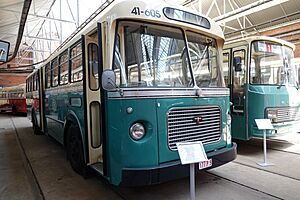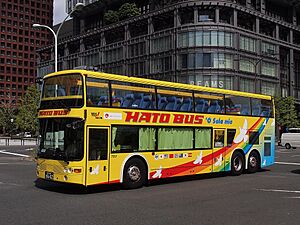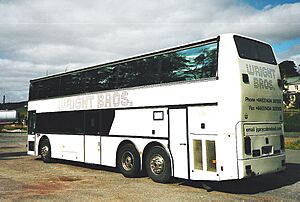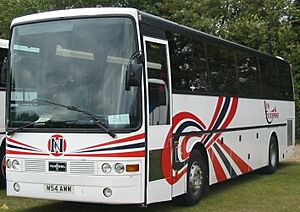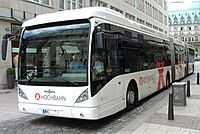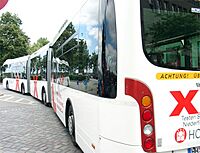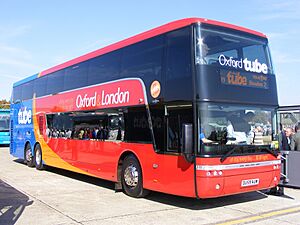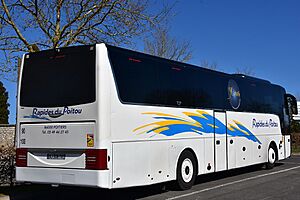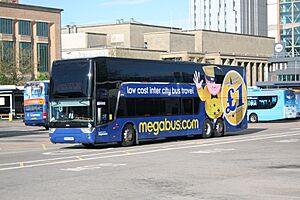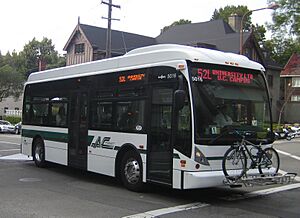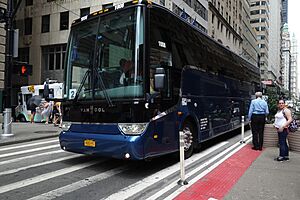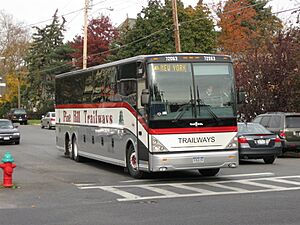Van Hool facts for kids
 |
|
| Private | |
| Industry | |
| Founded | 1947 |
| Defunct | 2024 |
| Headquarters | Koningshooikt, Belgium |
|
Key people
|
Bernard Van Hool (founder) Filip Van Hool (CEO) Marc Zwaaneveld (co-CEO) |
| Products | Bus Coach Semi-trailers |
| Parent | VDL Groep, VDL Bus, and Coach |
| Subsidiaries | Van Hool USA Van Hool North Macedonia ABC Companies |
Van Hool NV was a famous Belgian company that built buses, coaches (which are like fancy buses for long trips), and trailers. They were known for making high-quality vehicles.
Most of their buses and coaches were built completely by Van Hool. They used engines and other important parts from well-known companies like Caterpillar, Cummins, DAF, and MAN. Sometimes, they also built bus and coach bodies on chassis (the frame and wheels) made by other companies, such as Volvo and Scania.
Van Hool employed about 4,500 people around the world. Each year, they made more than 1,700 buses and coaches, along with 5,000 trailers. They sold many coaches in the United States.
Sadly, Van Hool faced financial problems and declared bankruptcy in April 2024. Soon after, two other companies, VDL from the Netherlands and Schmitz Cargobull from Germany, took over parts of Van Hool.
Contents
The Story of Van Hool
Bernard Van Hool (1902–1974) was a farmer in a place called Koningshooikt, in Belgium. He had eight sons and two daughters. Bernard first built his own bus to take workers to his farm. Other farmers saw his bus and wanted similar ones. This led him to start his company in 1947.
It was a true family business! Out of the first 22 employees, five were related to Bernard, including his brother-in-law and his four oldest sons. In 1954, the company changed its name to Van Hool en Zonen, which means "Van Hool and Sons."
In the beginning, Van Hool mostly built bus bodies on chassis from other companies. They soon started making many vehicles in a row (called serial production) and sold them all over Europe. Since the mid-1980s, Van Hool also sold its vehicles in North America.
Working with Fiat
On February 15, 1957, Van Hool made an important deal with Fiat, an Italian company. This meant Van Hool would use Fiat engines and other mechanical parts like gearboxes and axles in their vehicles. This helped Van Hool grow from just a body builder to a full manufacturer of buses and coaches in Belgium. These vehicles were known as Van Hool-Fiat.
Just a year and a half after the Fiat agreement, the 100th Van Hool-Fiat vehicle was delivered. By July 1961, they had made over 500! The partnership with Fiat ended in 1981.
Growing Around the World
Bernard Van Hool stopped managing the company day-to-day in 1969 and passed away in 1974.
Van Hool started selling in Japan in the early 1980s. The Meitetsu Group bought several Astromega double-decker buses for long-distance routes. Later, Hato Bus also imported some. Since 2016, Van Hool and Scania have worked together to create the TDX24 Astromega double-decker bus especially for the Japanese market.
In 1990, Van Hool bought the coachbuilding part of LAG Manufacturing in Belgium. They continued to make LAG's EOS models for about ten years.
Bankruptcy and New Ownership
In early 2024, Marc Zwaaneveld joined Van Hool as a co-CEO to help the company. He announced a plan to stop making city buses and move production to North Macedonia. However, the Van Hool family could not agree on the plan.
Van Hool officially filed for bankruptcy on April 5, 2024, and was declared bankrupt on April 8, 2024. This meant production stopped, and many jobs were at risk.
On April 10, 2024, it was announced that VDL, a bus maker from the Netherlands, and Schmitz Cargobull, a trailer maker from Germany, would take over Van Hool.
Van Hool Vehicles in Europe
In Europe, Van Hool offered many types of coaches. All their designs looked similar and were built on the same basic structure, called the TX platform. They used a similar idea for their city buses, called the A-series. In recent years, Van Hool also focused on new technologies, like buses that use fuel cells or a mix of diesel and electricity.
Past Models
T8 Series Coaches
The T8 platform was introduced in 1979. Over time, many different touring coaches were made from this platform. Each model had a number and a name. For example, in "TD824 Astromega":
- T meant Touringcar (touring coach)
- D meant Dubbeldek (double deck)
- 8 was for the T8 series
- 24 was the possible number of seat rows
- Astromega was the name for the double-deck coaches
An updated version, the "T8 New Look," came out in 1991. Production of the T8 series ended in the late 1990s.
Some of the T8 models included:
- Alicron: a standard single-deck coach.
- Acron: a single-deck coach with a higher floor.
- Astromega: a large double-deck coach.
A-series City Buses
In the 1980s, Van Hool developed its A-series city buses. The first one, the A500, came out in 1985. Like the coaches, these buses also followed a clear naming system. For example, in 'AG500':
- A meant Autobus (city bus)
- G meant Geleed (articulated, meaning it bends in the middle)
- 500 was the height of the floor in millimeters
The A-series was made until the early 2000s, when it was replaced by the newA-series.
Current Models (as of 2024)
T9 Series Coaches
The new T9 series for Europe was launched in 1995. It had a completely new design. Like the T8, it used one main structure for many different versions. Models included the Alicron, Acron, and Astron (standard coaches with different heights), the Altano (with a low driving position), the Astronef (with a sloping floor like a theater), and the double-deck Astromega.
TX Series Coaches
At a big bus show in 2011, Van Hool showed off the TX series, which replaced the T9 series.
newA Series City Buses
In 2001, Van Hool introduced the newA series city buses, replacing the older A series. These buses had a new look and many improvements.
ExquiCity BRT Solution
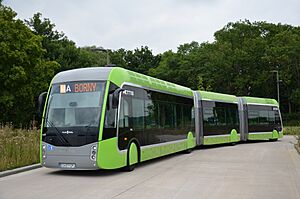
In April 2011, Van Hool launched the ExquiCity platform. These buses were designed for BRT systems, which are like trams but use buses. The ExquiCity buses look and feel like trams but have the flexibility and lower cost of a bus. They came in two lengths: the single-articulated ExquiCity 18 and the double-articulated ExquiCity 24. Both could be trolley buses, diesel-electric hybrids, fuel-cell hybrids, or fully electric.
EX Series Coaches
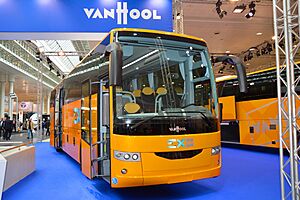
At a motor show in Germany in 2014, Van Hool showed its new EX series of coaches for Europe. These coaches are made in Van Hool's factory in Skopje, North Macedonia.
Van Hool Vehicles in North America
Because of different safety rules in the United States, Van Hool first only sold highway coaches there, starting in 1987. City buses from Van Hool didn't arrive until 2002. Van Hool's main dealer in the United States was ABC Companies.
In 2018, Van Hool planned to build a new factory in Morristown, Tennessee, to make public transit buses. It was supposed to open in 2020 and create 600 jobs. However, construction never started, and the plans were delayed due to the global COVID-19 pandemic. With Van Hool's bankruptcy in April 2024, these factory plans did not happen.
Past Models in North America
T8 and T9 Series Coaches
The T815 was first sold in the United States in 1987. Later models were known as the T8 series. They used Cummins diesel engines. The T9 series looked very similar to the T8 series and had similar parts, but with small updates.
A3 City Bus Series
Van Hool and ABC worked with AC Transit in California to test the A3 series city buses in 2002. The AG300 was a 60-foot articulated bus, and the A330 was a 40-foot bus. These low-floor buses started service in June 2003. AC Transit had many Van Hool buses in its fleet.
Van Hool also built hydrogen fuel cell buses for the United States. These buses were special because they were designed and built as fuel cell buses from the start by one company.
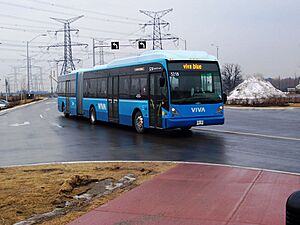
In 2008, AC Transit received new A300L 40-foot buses. These buses were unique because their engines were placed in the middle, between the front and rear wheels, to make the ride smoother. Riders liked the design and quality of these new buses.
Utah Transit Authority also bought A300L buses for its MAX bus rapid transit system. These buses had three doors and were made for cold weather and high altitudes.
York Region Transit in Canada used A330 and AG300 buses. Washington, D.C.'s Circulator also used A330 and A300K buses.
TX- American Version Highway Coach
Van Hool started making the TX40 and TX45 highway coaches in the US in 2015. Production of the TX series in the US stopped in 2018.
Current Models in North America (as of 2024)
T21 Series Luxury Coaches
Introduced in 1995, the T21 series had an updated design and more engine choices. It was available as 40-foot T2140 or 45-foot T2145 versions.
C2000 Series Coaches
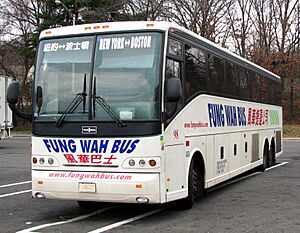
The C20 series was introduced in 2000 as a more affordable coach for long trips. It looked similar to the T21 series. Greyhound used a fleet of C2045s.
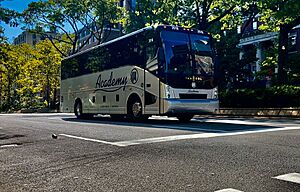
CX Series Coaches
The CX45 was introduced in 2013 as a redesigned C2045, with a new front, rear, and interior. In 2015, Van Hool also introduced a smaller 35-foot coach called the CX35 for the North American market.
In 2019, Van Hool released the CX45E, an all-electric version of the CX45. An electric CX35E is also being developed.
TD925 Astromega Double-Deck Coach
The TD925 Astromega is a double-decker coach that meets United States safety rules. It's a version of the TD925 Astromega coach available in Europe.
Van Hool Products
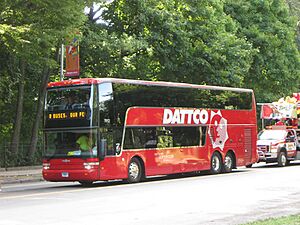
City Buses
Europe
- A308 midibus: a smaller bus with a low floor. Also available as a diesel-electric hybrid.
- A309 midibus: a low-entry bus. Also available as a diesel-electric hybrid.
- A300 standard bus: a full low-floor bus. Also available as a diesel-electric hybrid.
- A360 standard bus: a low-entry bus. Also available as a diesel-electric hybrid.
- A330 standard bus: a full low-floor bus. Also available as a diesel-electric hybrid.
- AG300 articulated bus: a bus that bends in the middle. Also available as a diesel-electric hybrid.
- AGG300 bi-articulated bus: a very long bus that bends in two places.
- A330T trolleybus: a bus powered by overhead electric lines.
- AG300T articulated trolleybus
- ExquiCity 18 articulated BRT bus: for bus rapid transit, available as hybrid, trolley, fuel cell, or electric.
- ExquiCity 24 bi-articulated BRT bus: for bus rapid transit, available as hybrid, trolley, fuel cell, or electric.
- A308E electric bus
- newA300K: a shorter 30-foot bus.
- newA300L: a 40-foot full low-floor bus.
- newA330: a 40-foot full low-floor bus.
- newAG300: a 60-foot articulated full low-floor bus.
Touring Coaches
Europe
- T915 Atlon
- T916 Atlon
- TX11 Alicron
- TX15 Alicron
- TX16 Alicron
- TX15 Acron
- TX16 Acron
- TX17 Acron
- TX18 Acron
- TX16 Astron
- TX17 Astron
- TX15 Astronef
- TX16 Astronef
- TX17 Astronef
- TX17 Altano
- TX18 Altano
- TX19 Altano
- TDX20 Altano
- TDX21 Altano
- TDX25 Astromega
- TDX27 Astromega
- EX15H
- EX16M
- EX17H
North America
- CX35
- CX45
- TD925 Astromega USA
Japan
- TDX24 Astromega (also called “J-InterCity DD” for intercity buses)

Trolleybuses
- Van Hool A300T
- ExquiCity Trolleybus
Airport Transfer Buses
- Van Hool AP1130
- Van Hool AP1137
- Van Hool AP1237
- Van Hool AP1325
- Van Hool AP2375
Van Hool in Motorsport
Van Hool used to own a racing team called Team Astromega. This team competed in racing series like International Formula 3000 and A1 Grand Prix. One of the drivers was Mikke Van Hool, a member of the Van Hool family.


